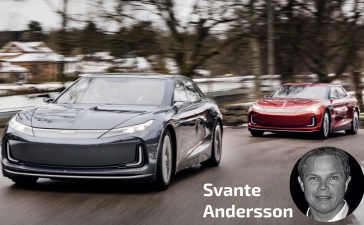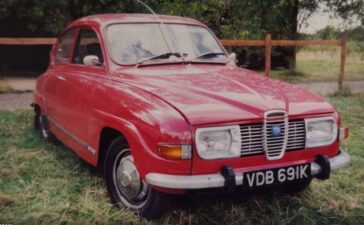The Saab 900 T16S remains one of the most enigmatic, innovative, and enduring sports saloons ever crafted. It wasn’t merely a car; it was a statement of engineering defiance, proving that Saab could challenge the conventions of automotive design. In a recent episode of The Gasoline Juice YouTube Channel, Matt Searle, long-time Saab aficionado and author of ICON Book (SPG 40th Anniversary: Four Decades of the Saab 900 Turbo 16S SPG), sat down with Cesar Pieri, former Jaguar Cars Creative Design Manager, to dissect the genius behind this timeless turbocharged masterpiece.
Table of Contents
- 1 Why the Saab 900 T16S Captures Enthusiasts Like No Other
- 2 Unpacking the Saab 900’s Unorthodox Engineering
- 3 Form Meets Function: A Designer’s Perspective on Saab’s Quirks
- 4 A Cabin Built Around the Driver—Aerospace Influence at Work
- 5 Driving a Saab 900 T16S—The Mechanical Connection
- 6 Saab’s Legacy: More Than Just a Car, A Way of Thinking
Why the Saab 900 T16S Captures Enthusiasts Like No Other
Saab has never been about following trends; it has always been about challenging them. The 900 T16S was born in an era dominated by wedge-shaped supercars and flamboyant body kits, yet it carved its own niche with a functional, aerodynamic shape that prioritized engineering over aesthetics.
As Searle recalls from his teenage years, the Saab Turbo models stood apart. They weren’t exotic Ferraris or unattainable Lamborghinis; they were real-world dream cars—performance-driven versions of the cars people actually drove. The T16S embodied Scandinavian rationality wrapped in an uncompromising performance package.
For those who grew up in the Max Power era, it took a while to appreciate the 900. But as the years passed, enthusiasts like Searle gravitated toward classic, mechanically engaging cars, and the 900 T16S proved to be the ultimate driver’s machine.
Unpacking the Saab 900’s Unorthodox Engineering
One of the biggest surprises for new Saab enthusiasts is how fundamentally different the 900 is from other cars. This was no ordinary front-wheel-drive vehicle—Saab’s engineering team made bold, unconventional choices:
- The engine is mounted backwards, with the clutch at the front and the belts at the back.
- It sits at a 45-degree tilt, lowering the center of gravity while making room for the iconic sloped hood.
- A chain-driven gearbox, a rarity in production cars, contributes to its uniquely engaging driving dynamics.
- Superior weight distribution—nearly all of its mass is over the front axle, providing relentless traction in any weather condition.
- An aircraft-style wraparound windshield that dramatically improves visibility—an influence Saab engineers loved to emphasize.
As Cesar Pieri points out, the 900 was never about adhering to traditional design principles. Instead, it broke them all—and in doing so, it created something entirely unique.
Form Meets Function: A Designer’s Perspective on Saab’s Quirks
Cesar Pieri, coming from his Jaguar design background, sees the 900 T16S as one of the most unconventional yet fascinating designs ever produced. As he notes:
- Its proportions defy expectations—it’s long, but the lines pull upwards in ways that don’t conform to standard automotive aesthetics.
- The side profile features negative surface sculpting, a design feature rarely seen outside of concept cars.
- The three-spoke wheels, a Saab signature, were groundbreaking in their time and remain an instantly recognizable feature.
- The flush door sills keep snow and debris out, a genius touch inspired by Saab’s cold-weather heritage.
- Even the sunroof mechanism is unique, using an electric motor housed in the trunk for a completely silent operation.
For Pieri, the Saab 900 is a designer’s paradox—many of its elements go against standard car design philosophies, yet collectively, they create a cohesive, iconic form.
A Cabin Built Around the Driver—Aerospace Influence at Work
Stepping inside a Saab 900 T16S is an experience in ergonomics and driver-focused design. Saab didn’t just make cars; they built cockpits—every switch, dial, and control was positioned with purpose.
- Large, easy-to-operate buttons designed to be used with thick gloves.
- A deeply recessed dashboard, giving a spacious and panoramic forward view.
- Heated front seats, a luxury far ahead of its time, reflecting Saab’s commitment to all-weather comfort.
- An additional ‘Extra’ switch, allowing owners to customize their interior functionality—Matt Searle repurposed his to activate a subwoofer under the seat.
The wraparound windshield and slim A-pillars were particularly striking to Pieri, who noted that modern cars rarely offer such unparalleled visibility.
Driving a Saab 900 T16S—The Mechanical Connection
Driving a 900 T16S isn’t about sheer horsepower—it’s about feel, balance, and engagement. With 185 horsepower, it won’t set quarter-mile records, but its mid-range turbocharged power delivery was unmatched in its era.
- In the mid-1980s, few cars could keep up with a Saab 900 T16S in real-world acceleration.
- Thanks to its progressive turbocharging, the power delivery is smooth yet potent, avoiding the dramatic turbo lag of earlier models.
- The steering is weighty, the gear shifts mechanical, and the brakes require effort—it’s a car that demands interaction, and that’s precisely why enthusiasts love it.
- Despite its quirky nature, the 900 T16S remains a remarkably capable grand tourer, effortlessly covering long distances in comfort.
As Matt Searle puts it: “This isn’t just a car—it’s an extension of its driver.”
Saab’s Legacy: More Than Just a Car, A Way of Thinking
The Saab 900 T16S isn’t just a product of its time—it’s a testament to the innovation, resilience, and engineering brilliance of Saab. While many cars from its era have faded into obscurity, the 900 remains a cult icon, celebrated by enthusiasts, designers, and automotive historians alike.
If you’re a Saab fan, this video interview with Matt Searle and Cesar Pieri is an absolute must-watch:
Their insights offer a rare behind-the-scenes look at why this car continues to captivate people decades after it first hit the road.












Yes Superswede Car Icon windscreen same as air force
Měl jsem ho super car
Super sweede super cool and as a T16S fast